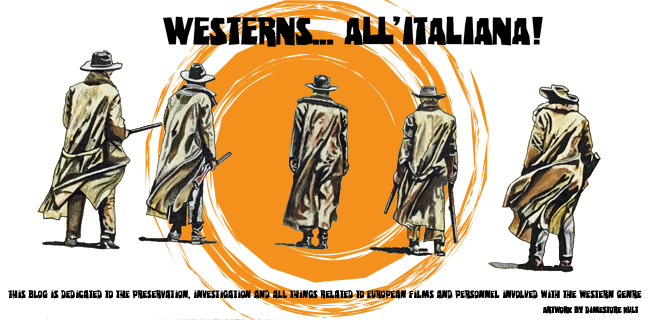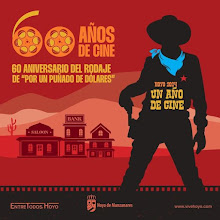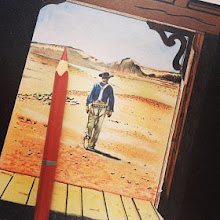THE RESTORATION OF THE MOVIE - BY ADRIANO APRA’ AND MARIO
MUSUMECI
(from the book “Il Buono, il Brutto, il Cattivo” di
Sergio Leone – edited by SNC, Scuola Nazionale di Cinema)
The movies by Sergio Leone show from a technical and
editorial point of view an undeniable “author’s” mark.
The analysis of the material, the negatives, copies,
duplicates and the various editions, the documents and the statements by
friends and collaborators, all clearly reveal an image of a true artist and
craftsman, an all-round movie man with a unique love for his job and with an
enormous competence, an author who followed his movies by himself step by step,
of course having extremely valid collaborators on his side like Luciano
Vincenzoni, Nino Baragli, Tonino Delli Colli, from the story to the screenplay,
editing, and cutting the final product, either extending or reducing it for the
foreign markets.
Whoever deals with the restoration of the Leone movies,
finds himself having to deal constantly with a considerable number of
variations, all called “by the author”; it was quite normal that Leone until
the very last minute before the premiere, would work personally on the copy of
the film ready for the release, by cutting and editing first hand, even
anticipating the censors or the demands of the market.
To all this, one has to add, like always, that a great
number of sources (more or less respected) would report different figures
concerning the length, censor cuts, unedited material etc., and in many cases
they were second hand reports or hearsay. Considering all this, one can
understand the complexity of a preliminary work of research in order to obtain
a reliable end result. Not to mention the technical problems.
Il Buono, il Brutto, il Cattivo is no exception, as we
will see.
From many different sources on Leone films, the length of
Il Buono, il Brutto, il Cattivo (the original Italian version) varies from 180’
to 182’ (let’s keep in mind that according to various sources, for the
different dubbed versions for the foreign markets, the length is stated as 166’
for France, 161’ for USA, 148’ for U.K.).
We do not know exactly from which sources the length of
the Italian edition is determined; certainly not from the length indicated in
the censor’s approval dated 20th December 1966 which states 4.840 meters
equivalent to 176’54”. This figure, lacking a proper measurement done on the
actual copies (or on the VHS tapes, provided they have not been cut and keeping
in mind to recalculate the length obtained with 25 frames per second into 24
frames per second) is still the only “official” source, but it is not always
reliable.
Very often some heavy discrepancies (reduced or increased
length) have been reported, often simply because the meters for the censors had
been calculated including the closing credits or sometimes even by a rough
guesstimate.
In the case of the Leone movie however, this length is
quite close to the copy acquired in 1970 and still owned by the Cineteca
Nazionale (4.832,80 meters or 176’39”), which includes the subsequent
“lightening cuts” of 3363 frames which will be referred to further on and which
is missing however a few frames due to wear.
This figure is also close to the original ”2p” negative, to
the track negative, to the positive duplicate dated 1982, to the 1996 duplicate
negative and the relevant positive copies.
From a comparative examination of the different materials
– as can be seen on the enclosed appendix/table – one can see that there are no
substantial differences in the various materials, but only slight differences
due to different ways of measuring, roundings, usage of different conversion
tables meters/minutes and slight discrepancies in the seconds/frames.
We can therefore consider the figures of 180’ or 182’ as
wrong (maybe, but it is not known on which sources this is based upon, it
included two scenes which had been shot but never used for the movie, which we
will talk about later on).
In order to establish the correct length of the film to
restore, we think it is the correct choice to use the Cineteca Nazionale copy,
the existing negatives, the intermediate material and also the length declared
by the censors.
A further problem however arises from the 1969
re-edition, which according to the figures in the “Cinematographic Review”
shows a cut of 540 meters, whereas the copy kept at the Cineteca
Nazionale (where it was deposited at the time, like many
other films, by those ministerial offices) shows cuts of only 346 meters. Was
it just a banal transcription error, “5” instead of “3”?
The only solution is to let the existing material “talk”.
The first element to take into consideration is the
positive copy, the only one existing since 1970 at the archives of the Cineteca
Nazionale, where since 1965 a copy of all Italian movies had to be sent for
safekeeping.
This is a copy, printed in Technicolor, of rather poor
color quality (most probably being one of the very first copies printed before
the release), but which has the merit of being one of the longest copies among
those preserved.
A first flashback.
The film was finished and screened for the first time on
23rd December 1966. In those days, the film critics were far from appreciating
Leone’s films, underlining, since the release of Fistful of Dollars, the
excessive violence in his movies. So certainly this influenced Leone’s choice,
as stated verbally by some of his collaborators, to make some small cuts until
the very last minute on the movie ready to be screened for the first time.
They were mainly concentrated on reel 6A (the eleventh),
the beating scene of Tuco (Eli Wallach) by Corporal Wallace (Mario Brega), by
orders of Sentenza (Lee van Cleef). The scene was cut by 2.876 frames, equal to
roughly 2 minutes, eliminating the most violent scenes.
At the same time, as an intelligent and evident narrative
choice, Leone decided to shorten slightly the scenes which alternate the
beating, the ones showing the prisoners forced to sing in order to cover the
cries of the poor victim.
A further very short cut, 487 frames or about 20 seconds,
was made in the final sequence when Tuco was left standing on the cross by
Blondie with the noose around his neck.
All these cuts, and this is an unique occurrence in the
history of this movie, have been reproduced on the original negative,
substituting the 3.363 frames which had been cut with the same number of
transparent frames in order not to lose the original length and the synchrony
with the soundtrack.
30 years later, when Metro Goldwyn Meyer started to work
on a complete version of a video to be distributed in the States (the version
distributed up to then was 15 minutes shorter) they realized they received from
Italy a copy obtained from the original negative, with approx. 2 minutes of
black frames, but with an intact soundtrack.
In the fall of 1999, MGM knowing that the Cineteca
Nazionale owned a presumably integral copy of the movie, asked for permission
to check it. Thanks to this exchange of information with MGM, the first idea of
a restoration project was born, which during the successive months was defined
and completed by the Cineteca Nazionale, with the decisive and crucial
collaboration and contribution by Alberto Grimaldi Productions and by the Leone
family.
It was then discovered that the copy owned by the
Cineteca Nazionale in fact has no cuts and includes the missing 3.363 frames as
described above, the ones that had disappeared from on the negative.
Concerning these cuts, it was however decided not to
include them in the restored version, but in any case they have been duplicated
and preserved, since they are regarded as a document; in fact, these cuts have
been deemed to be choices of expression made by the author, confirmed by the
painstaking deletion on the negative.
[To be continued]











No comments:
Post a Comment